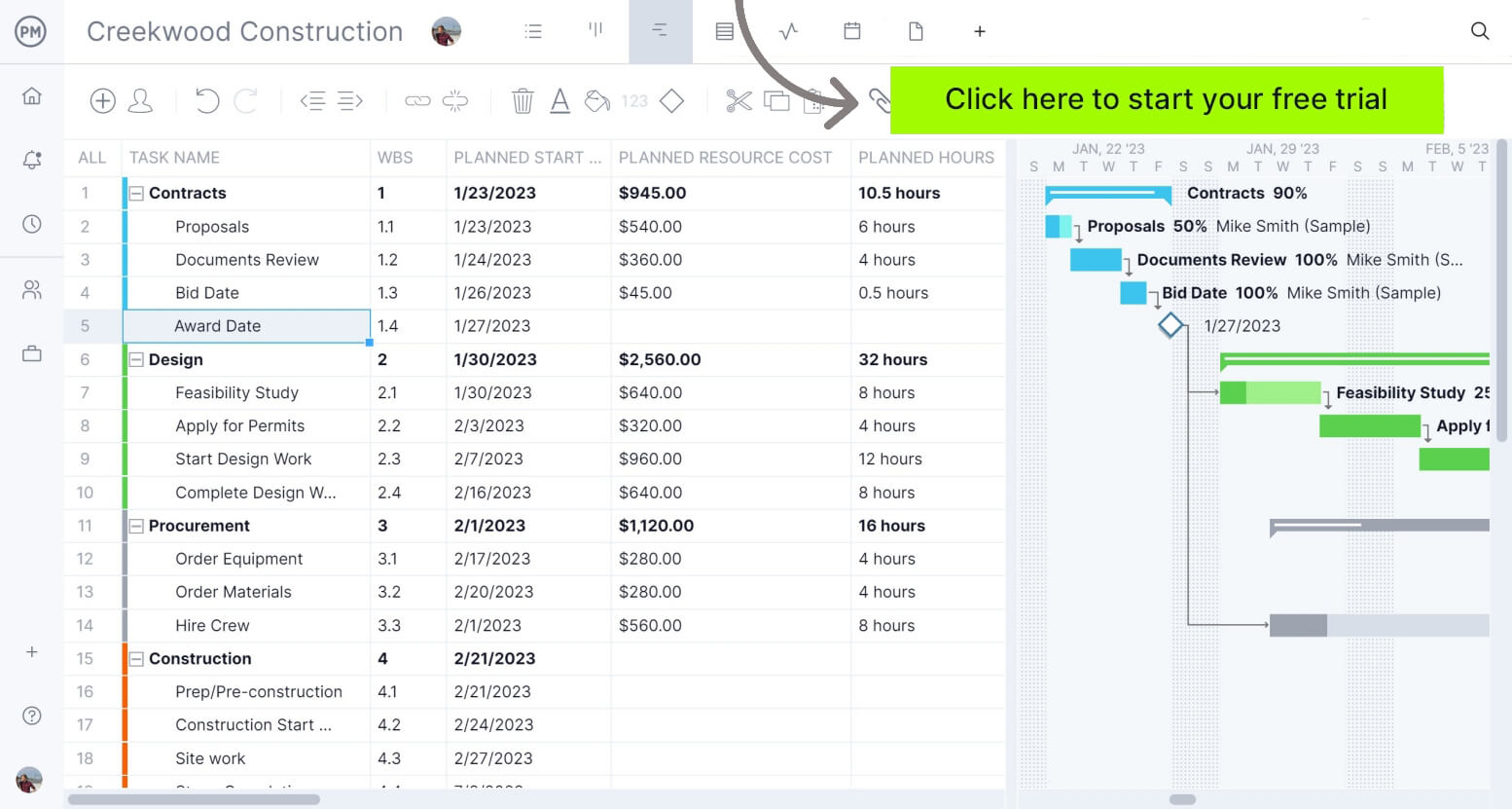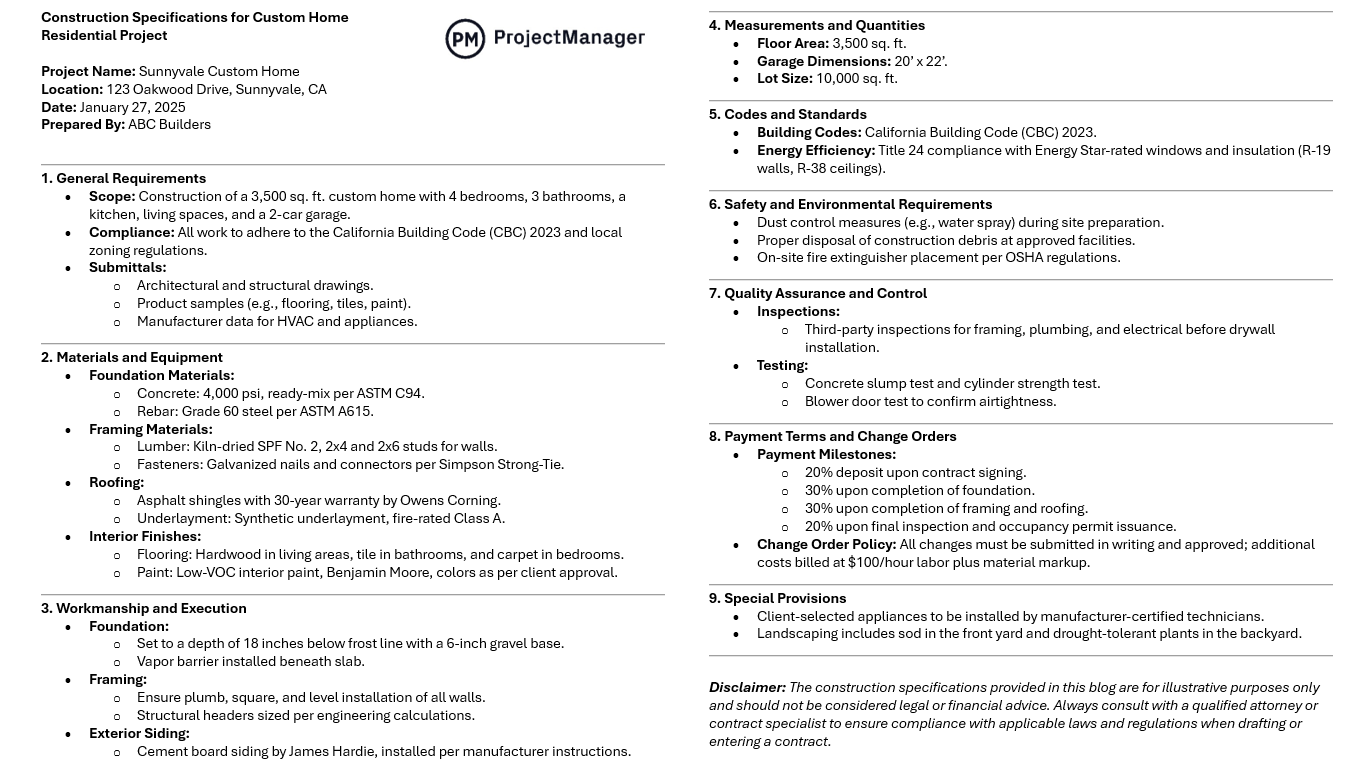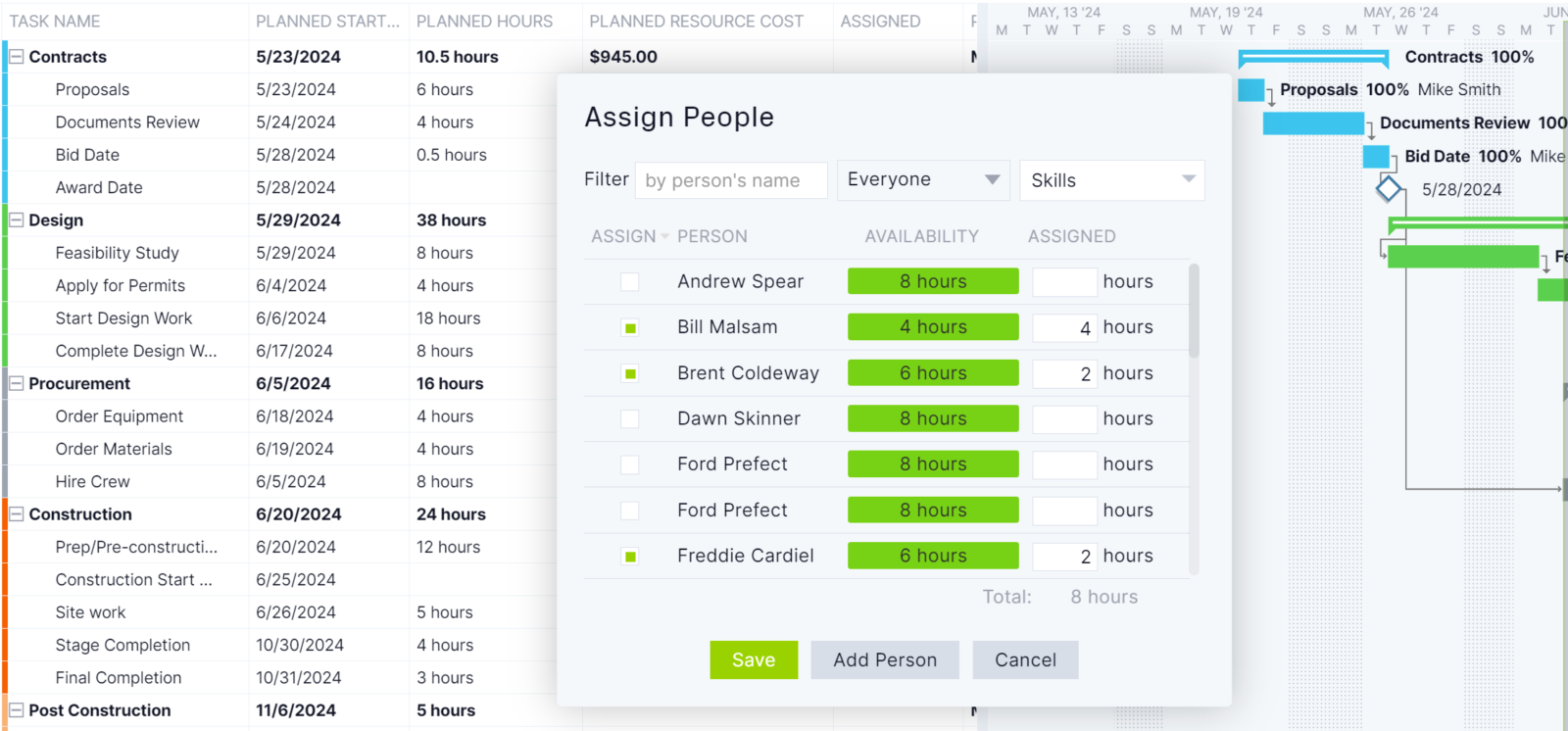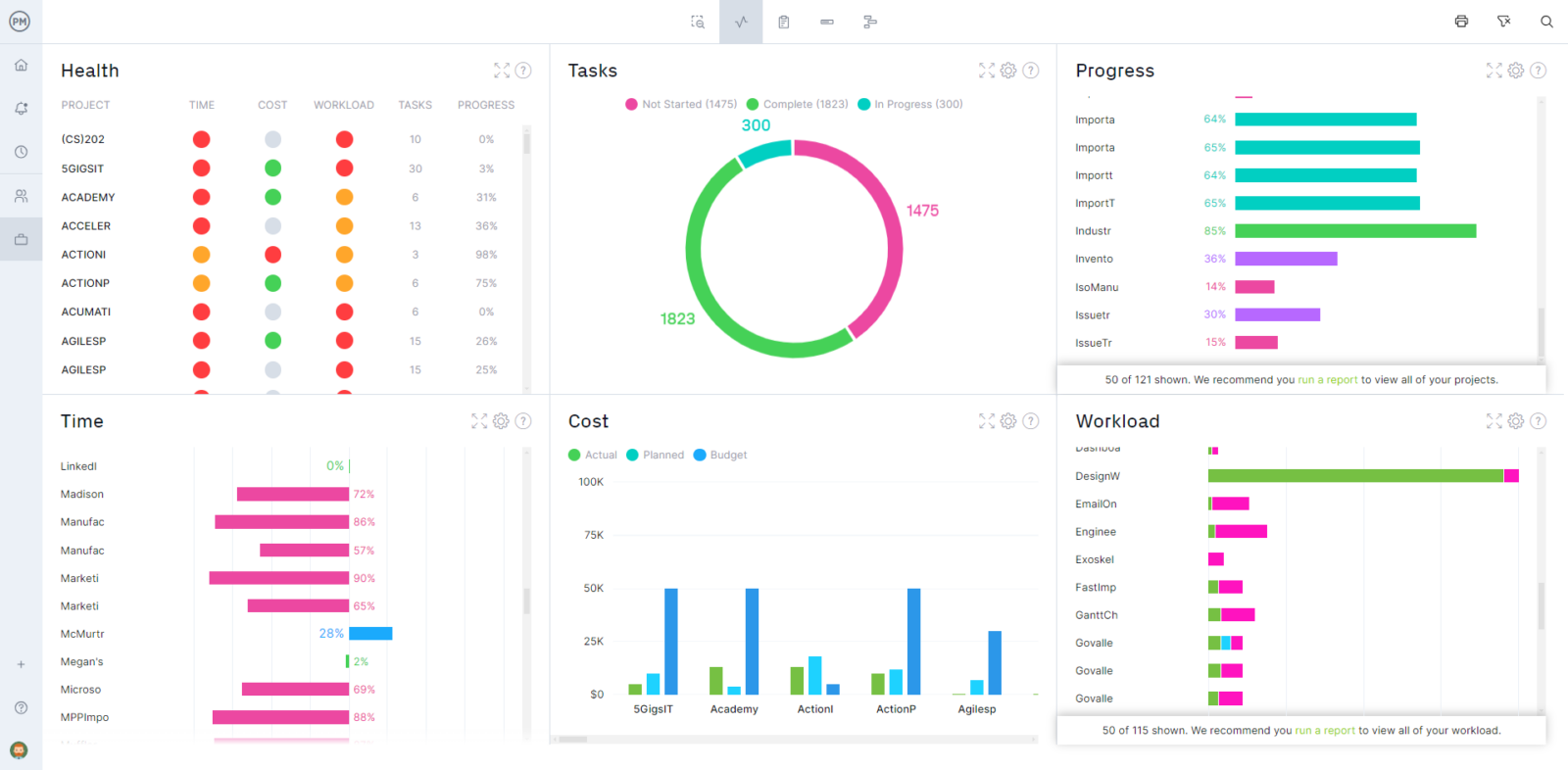Construction companies have to do some heavy lifting, and that’s not just the steel and concrete they use to erect buildings, bridges and other structures. Many different types of materials and labor go into their work which requires their contracts to have construction specifications.
There are many types of specifications in construction. We’ll explain what construction specifications are, why they’re so important and detail the different types. Then we’ll go a step further by offering free templates and software that can help with construction project management.
What Are Construction Specifications?
Construction specifications are the products, materials and work that are defined in a construction contract between a construction owner and the construction manager hired to deliver the project. They’re used in the construction industry as part of the larger group of construction documents that include quantities, schedules and drawings.
Cost, quantity and drawn materials aren’t included in the construction specifications but serve as complementary assets. It’s through the construction specifications, as well as other construction documents, that the expectations and objectives of the client are matched with the project. Therefore, understanding what makes up the construction specifications is key to delivering a successful construction project.
Related: Free Construction Project Management Templates for Excel
Details in the construction service contract highlight what’s important to fulfilling the project to a client’s expectations. The construction document is referenced throughout the life cycle of the project by contractors and construction crews if they have questions. Some information in a construction specification includes the scope of work, materials, a timeline with milestones, methods of installation, quality of workmanship, testing requirements and safety standards.
Construction specifications are critical to project planning. ProjectManager has multiple project views that map out the project plan and schedule. Everyone from construction managers to architects, engineers and construction workers can view plans on the tools most helpful to them. Managers can add tasks to a timeline, link all four dependencies and filter for the critical path on powerful Gantt charts. Others can view their work on kanban boards, task lists or calendar views. Once the plan is made, set a baseline on the Gantt chart and it’s easy to track your planned effort against your actual effort to help you stay on schedule and within budget. Get started with ProjectManager today for free.

When Are Construction Specifications Defined?
Construction specifications are typically created during the design phase of the project, before the construction phase begins. They are developed in parallel with architectural and engineering drawings, and are finalized once the project design is complete.
Who Should Manage Construction Specs?
The construction specifications are usually created by the architect or designers of the project. Project engineers can also be involved. They can delegate the work or enlist professional specification writers, especially on more complicated, larger projects.
All of this is done before the project to ensure that the design plan is properly executed. This process reduces risks in the project and helps to deliver the project on time and within its budget.
Once the construction specifications are completed, contractors on the job will often use them to supplement the architectural drawings and blueprints. This helps them to describe and document information that might not be visually clear.
What Should Be Included in Construction Specifications?
Construction specifications are critical documents that outline the requirements and standard for a construction project. They provide clear instructions for contractors, suppliers and subcontractors to ensure quality, consistency and compliance throughout the construction process. Below are its key elements.
1. General Requirements
This section outlines the project’s scope, goals and deliverables. It includes contract types, timelines, roles and responsibilities, and any pre-construction activities that need to be completed. It also defines the overall project framework and administration procedures.
- Project scope of work, overview, and objectives.
- Roles, responsibilities, and regulatory compliance.
- Submittal requirements (shop drawings, samples, and documentation).
2. Materials and Equipment
Specifies the materials, products and equipment that must be used in the construction project. This section defines the quality, brand and type of materials required for each part of the project, ensuring consistency and durability. These parameters will guide the creation of a bill of quantities, which will further define the quantities of materials and resources needed.
- Detailed descriptions of materials and equipment.
- Grades, types, performance standards, and approved manufacturers.
- Specific units and dimensions for each element.
3. Workmanship and Execution Guidelines
Provides detailed instruction on how tasks should be executed and what quality of workmanship is expected. This includes standards for installation, finishes and handling materials to ensure the work meets the required level of quality and performance.
- Standards for installation, tolerances, and quality.
- Construction methods, sequences, and special procedures.
- Cleanup and waste management.
4. Building Codes and Standards
Lists the local, state and national building codes that govern the construction project. These codes ensure that the project meets safety, accessibility and environmental regulations, and adheres to industry standards and best practices.
5. Safety Protocols
Specifies the safety measures that must be followed to protect workers, the public and the environment. This includes guidelines on protective equipment, safety training, hazard identification, emergency procedures and reporting requirements.
- Personal protective equipment (PPE)
- Safety training
- Emergency procedures
6. Environmental Considerations
Outlines requirements for environmental protection, including waste management, pollution control, energy efficiency and sustainable building practices. This ensures the project minimizes its environmental impact and complies with relevant laws and regulations.
- Waste management
- Energy efficiency
- Pollution control
7. Quality Assurance and Control Guidelines
Defines procedures for monitoring and ensuring the quality of materials, equipment and workmanship throughout the project. It outlines testing, inspection processes and how issues will be addressed to meet the required quality standards.
- Inspection requirements
- Testing protocols
- Deficiency corrections
8. Payment Terms
Specifies how and when payments will be made to contractors and subcontractors. It includes details on payment schedules, conditions for payment releases, invoicing processes and penalties for delays or non-compliance.
- Payment schedule
- Invoice procedures
- Late payment penalties
9. Change Order Management
Describes the process for handling changes to the project scope, cost or schedule. This includes how change orders should be documented, approved and implemented, as well as how costs and timelines will be adjusted.
- Approval process
- Cost adjustments
- Impact on schedule
10. Special Provisions
Covers any unique requirements or conditions specific to the proejct that are not addressed in other sections. These provisions could include special construction methods, coordination with other contractors or particular site conditions that need to be considered during the project.
- Unique requirements
- Site conditions
- Additional contract terms
Construction Specifications Example
The construction specifications document below shows the specifications for a custom-home residential project. You may download this free sample by clicking the image below.

Types of Construction Specifications
There are a few types of specifications in construction project management. In general, you’ll find three main categories of construction specifications: prescriptive, performance and proprietary. Let’s take a closer look at each.
Prescriptive Construction Specifications
This is a step-by-step construction specification, providing details on materials and how the installation should be done. Prescriptive construction specifications can be divided into three categories: general provisions, required products and execution procedures.
General provisions are building codes and standards for the state, but also nationally, and must be compiled by contractors. Required products are the materials and resources to meet the structural and performance requirements. Execution procedures are the best methods of installation and how to measure quality and effectiveness once the project is done.
Performance Construction Specifications
These are operational requirements for the project once it’s done. It’s not a step-by-step breakdown of each task as you’ll find in the prescriptive construction specifications. Instead, the details of how the work is done are left up to the contractor. The only caveat is that the delivery of the project meets the objective of the client.
Proprietary Construction Specifications
This type of construction specification is used by contractors when working on projects with very specific material and resource requirements. For example, proprietary construction specifications are often used in renovation or when a subcontractor has been hired to complete work on an existing structure. The construction specs will have information on the existing structure and list the other materials that are like that structure that’ll be used to finish the work.
Standards for Construction Specifications
There are various organizations that have created standards for construction specifications, which helps project owners and contractors ensure the construction specifications for their projects are comprehensive and no details will be omitted.
CSI MasterFormat
- Purpose: The CSI MasterFormat is a widely adopted system for organizing construction specifications. It provides a standard structure for organizing all documents related to construction, including specifications, drawings, and other project details.
- Structure: The MasterFormat is organized into divisions and sections. The main structure is divided into 50+ divisions, each covering a specific aspect of construction work, such as sitework, concrete, masonry, electrical, mechanical, etc. Each division is further broken down into detailed sections that cover specific work results, processes, and materials used.
Uniformat
- Purpose: Used for organizing project specifications based on systems and assemblies rather than materials or tasks.
- Structure: Divides projects into categories of work like substructure, shell, interiors, services, etc., which are further broken down into components.
- Use: Primarily used in the early design phases for conceptual cost estimation and cost planning. It provides a system for cost estimation, budgeting, and organizing design information.
OmniClass
- Purpose: A classification system that supports a wide range of construction industry needs, including cost estimation, project planning, and information management.
- Structure: Organized into tables covering different aspects of a construction project like work results, spaces, products, and services.
- Use: Used for classifying construction information, especially for organizing detailed design and building components in the building lifecycle.
MasterSpec
- Purpose: A product of The American Institute of Architects (AIA), MasterSpec is a comprehensive set of specifications for design professionals to use in creating detailed project specifications.
- Structure: Like the CSI MasterFormat, it is organized by divisions and sections, detailing specific materials, processes, and requirements.
- Use: Primarily used by architects and engineers to create construction documents for all types of projects.
Why Are Construction Specifications Important?
Naturally, a construction project can’t happen if there aren’t construction specifications to outline the materials and labor needed to deliver it. That’s the obvious reason, but there are more that make it critical to a project’s success to have thorough construction specifications.
Improved Accuracy
First, the more details, the better the final product. Details lead to greater accuracy and less room for mistakes that can cost a project time and money, let alone not deliver on a construction owner’s expectations. The construction specifications in the service contract will guide the construction crew as they execute their tasks. This means that the work is more likely to be done correctly and delivered on schedule.
Set Expectations
Construction specifications are also important in that they set up expectations between the construction company and its client. Before the project begins in earnest, both parties have a clear understanding of what’s to be done, which helps avoid delays due to miscommunications.
Accurate Cost Estimations
One of the most important aspects of construction specifications is money. That’s because construction specifications detail all the materials and labor required to execute the project, leading to a more accurate estimation of project costs. Contractors especially appreciate this as if they miss the financial forecast for the work they’ll be doing that difference will come out of their pockets.
Free Construction Project Management Templates
A construction specification is going to feed into your proposal, plan and schedule. You’ll need to make accurate estimates based on what’s included in the construction spec to bid and create a timeline for executing the project.
ProjectManager is powerful construction project management software, which we’ll get to in a moment, but it’s also an online hub for free resources to help you through every phase of your project. We offer a variety of free construction project management templates for Excel you can use to manage all aspects of your project.
Construction Estimate Template
Knowing the materials and labor that will be required to construct whatever structure is being contracted is a big help, but you still have to accurately forecast those costs or pay for it out of your own bottom line. Using our free construction estimate template for Excel allows you to capture the direct, indirect, labor and material costs that are part of the construction job you’re bidding for. That way, you can put in a competitive bid that is accurate and profitable.
Construction Schedule Template
Knowing what you need and how much it’ll cost is only part of the job. You’re also going to have to deliver on time. In order to figure out how to get everything completed by your client’s deadline means you’re going to have to schedule the work carefully. Using our free construction schedule template is going to get you there by addressing everything from deliverables, resource management, milestones and even filters for the critical path.
Construction Proposal Template
Estimating and scheduling are all done to lead up to the proposal. They both give you more details so your proposal can be both competitive and financially in your interest. Our free construction proposal template for Word will help you in the bidding process for the construction job. Our free proposal template has everything you need to land that job, from detailing the scope of work, financial information to the project schedule and more.
ProjectManager Helps You Keep Track of Construction Projects
Once you have that job, you’ll need project management software to meet that budget and schedule. ProjectManager is award-winning construction project management that helps you plan, manage and track your work in real time. Plans can be easily shared across different tools that update together to keep everyone on the same page, plus there are features that help with tracking and resource management.
Track Progress With Real-Time Dashboards
To stay on your schedule and not overspend, you need to monitor your work and have metrics to let you know where you are actually compared to where you planned to be. Once you’ve set a baseline on the Gantt chart, simply toggle over to our real-time dashboards, which automatically collect project data and display it in easy-to-read graphs and charts. See everything from time to cost, workload and more. Best of all, unlike lightweight tools, there’s no time-consuming configuration required. Our dashboard is ready to report when you are.

Track Labor Costs With Workload Charts and Timesheets
If your resources get out of hand, it’s going to cost you and eat into your profit. Being able to track labor costs allows you to catch issues quickly and resolve them. When you onboard your crew you can add their availability, including PTO, vacations and global holidays, which makes assigning easier. Then go to the color-coded workload chart and see if anyone is overallocated. If you notice anything is off, balance the workload right from that page. Then there are our secure timesheets where workers can log their hours from anywhere. You can also track the percentage of their tasks that are done to make sure they’re keeping to the schedule.

There are other features, such as reporting, to help you stay on schedule and keep to your budget. It’s easy to generate a project status, workload or variance report and filter the results to show only what you want to see. Reports aren’t only customizable but easy to share with stakeholders to keep them updated on progress.
ProjectManager is online construction project management software that connects everyone on the project in real time. Whether you’re on the job site, in the office or anywhere in between you can comment, share files and more. Our collaborative platform leads to greater productivity and transparency. Get started with ProjectManager today for free.


